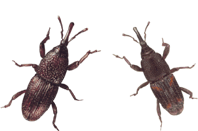Pantry Pests
Rid your home of unwanted pests with guaranteed service from Eagle Pest Control. Eagle’s pest control maintenance service is designed to keep you home pest-free by creating a protective barrier around the exterior of your home. We use extremely effective, long-lasting products that are safe to use in homes, schools, day cares, and food service establishments.
Our full-service maintenance plans are inclusive of all general household pests. You will have a pest-free environment, both inside and outside of your home or business – Guaranteed.
For additional resources, surf to:
Your Trusted Choice for the Best in Pest Control
One Source for Many Resources
Eagle Lawn Service is a division of Eagle Lawn Service & Pest Control. We specialize in caring for your lawn, as well as riding your house of bugs, termites or other unwanted creatures. It’s your home. We provide a service that works so you don’t have to.
ADDITIONAL INFORMATION ON THESE COMMON PESTS:
Cigarette and Drugstore Beetles
Cigarette and drugstore beetles are similar in habits and appearance, and sometimes confused with each other. The cigarette beetle is named for being a pest of stored tobaccos of all forms. The drugstore beetle is probably named for infesting various herbs used for medicinal purposes in the past. Both beetles are around 1/10" long, though the drugstore beetle is slightly skinnier in proportion to its length. These beetles have a hunchback, which is apparent from the side - making their heads hard to see from the top. Coloration for both beetles is brown. However, the cigarette beetle is lighter brown, and the drugstore beetle can have some reddish brown color. To distinguish the two species, usually takes a magnifying glass. Up close you can see the drugstore beetle has little punctures on its back that are arranged in rows. The beetle larvae for both species are practically indistinguishable from each other. They are around the same length as the adults, white colored with a darker head, and curled into a "C" shape. The adults and larvae are both able to chew through various types of packaging to get to stored products, spreading the infestation. Things they will eat include flour, grains, dried foods, spices, dried flowers, dog food, dried meats and leathers, paste from books, and even pyrethrum pesticide. The drug store beetle has a more varied appetite than the cigarette beetle, but they can both be found in the same items. Adult beetles can fly, and are attracted to lights at night. Their presence around lights can be an early warning sign of infestation.
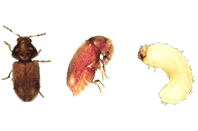
Red Flour and Confused Flour Beetle
The confused flour and red flour beetles look almost identical, which is probably how the confused beetle got its name. They are both reddish brown beetles, around 1/8" long. Careful examination of the thorax and antennae must be made to differentiate the two. The red flour beetle has a more rounded thorax, and its antennae end in 3 distinctly larger segments. The antennae segments of the confused flour beetle gradually get larger until the end. Another difference is that only red flour beetles can fly, but they may not do it very often. Both types of beetles are fast moving, and will quickly run for cover if disturbed. The female lays small, sticky eggs in food material and can live up to several years. When the larvae hatch out they can grow to be a little bigger than the adults, and are colored white and yellow. As the name "flour beetle" implies, these beetles can only eat grains that are processed or damaged. Along with processed grains, they sometimes target other dried foods and spices. The confused flour beetle is the biggest pest of commercial mills in the US, and is sometimes brought into the home inside foods bought in the store.

Hide and Larder Beetle
Hide and larder beetles are similar in behavior, but somewhat different in appearance. Hide beetles are up to 3/8" long, and usually black with a white underside. Larder beetles are the same size, without a white underside but have a horizontal light yellow band on their back. Larvae for these beetles are both up to 5/8" long, with long hairs. Hide beetle larvae have a light yellow stripe along the length of their body, that the larder beetle larva lacks. Both types of beetles prefer to eat products of animal origin. Leather, hides, animal trophies, dried meats, pet foods, dead animals, and dead insects are all eaten by both types of beetles. These are the beetles that are sometimes used by museums to clean any remaining flesh particles off of skeletons. Larder beetles are more likely to be found in stored food, and hide beetles are more likely to be found in hides or leather - but they both can be found in the same places. Hide beetles can be a problem in chicken houses, where they get into food, droppings or feathers. Both beetles can infest dead animals in wall voids, or bird nests. In these cases they can be difficult to control, since the larvae will travel a great distance from the source. When the larvae mature, they look for a place to pupate. Generally they look for a hard surface to bore into, such as wood, cork, or drywall - sometimes crawling up walls 20-30 feet high. In bad infestations they can cause enough damage to be of structural concern.

Merchant Grain and Sawtoothed Grain Beetle
Merchant grain and sawtoothed grain beetles are so similar, they were considered to be one species in the past. They are around 1/8" long, brown, with saw-like teeth on their sides. Adult merchant grain beetles are attracted to light and can fly, whereas sawtoothed grain beetles don't do either one. Sawtoothed grain beetles are considered to be a bigger pest of stored products overall. Larvae are the same size as adults, and feed on the same types of products, though they will leave whole grains alone. Things they both feed on include cereal, popcorn, rice, flour, nuts, dried fruits, spices, and dog food. Merchant grain beetles prefer oilseed products. Nuts, cereals, and cookies are some of their favorites. Both types of beetles can chew through, and work their way into many types of sealed packaging. Cardboard, plastic, and foil don't always stop them from getting to the food inside.
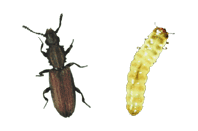
Warehouse Beetle
The warehouse beetle is named for being a pest of stored goods in warehouses. The adult is around 1/8" long, and colored dark brown with lighter colored markings. They can chew through most types of packaging, even when well intact. Warehouse beetle larvae can grow up to twice as long as the adults, and do the most damage. Both adults and larvae eat almost any stored food product, along with dead animals and insects. The larval stage eats a lot more than the adults, and prefer foods of higher protein when available. They are also very active looking for new food, and prefer the dark. The larvae are covered in so many long hairs, they appear fuzzy. These hairs are shed from their bodies, and end up in the food they are infesting. Since the hairs are too small to be sifted out, any food with these beetles should be thrown away as they can cause health problems if eaten.
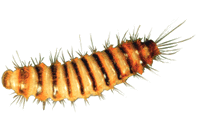
Lesser Grain Borer
The lesser grain borer is named for being the smaller grain borer in its family. These beetles are around 1/8" long, and dark brown in color. It is a hunchback beetle, with its head difficult to see from the top side. Grain borer larvae are the same size as the adults, white colored, and "C" shaped. These pests can reproduce rapidly under warm conditions. Both adults and larvae chew into whole grains to eat the insides, leaving behind dust and shells. Larvae will bore into grains, and mature inside them during various stages of development. They prefer whole grains, but will infest various other types of processed foods as well. Adult beetles are attracted to light, and good fliers. Their ability to fly can cause infestations to spread more rapidly. Like most other pantry pests, they can chew through all kinds of packaging to get inside. Typically a strong, sweet odor is present coming from the infested product.
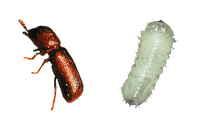
Angoumois Grain Moth
The Angoumois grain moth is named after the area in France where it was first noted infesting grain. These moths are around 1/3" long with a wingspan of ½", and colored a shade of tan or light brown. Adult moths are also attracted to light. Angoumois moth larvae are less than ¼" long, and white. The adult moth stage doesn't cause damage, but lays the reddish eggs that hatch into damaging larvae. Preferred foods are whole grains like corn, rice, barley, or seeds. They have been known to infest grain both in the field, and in storage. The larva chews its way into the grain leaving a small, but visible hole. Sometimes they will spin cocoon material on the grain before they enter. After feeding on the inside of the grain, the larva eventually goes into a pupa stage and will later discard the ruined kernel. Angoumois moths generally only infest the surface of stored products - the first few inches or more, and seldom over a foot deep. Infested grain will have a bad smell, be lighter in weight, and have debris present on the surface. Although they will infest dried goods, they seem to have a preference for dampness.
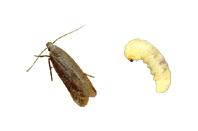
Indianmeal Moth
The Indianmeal moth is named for infesting a type of Indian cornmeal, though they will feed on many other things. Adult moths are around 3/8" long, with a wingspan of up to 5/8" wide. They are sometimes confused with clothes moths, but they are easy to distinguish if you know what to look for. Indianmeal moths are colored tan to gray, with a reddish brown band on their wings. The band on their wings also has somewhat of a copper shine to it. Clothes moths are a solid, subdued color. These meal moths are also not really active in the daytime, and are attracted to light. The moth larvae are slightly bigger than the adults, and do all of the damaging feeding. They are mostly colored white, but can have different tints of color depending on what food they are eating. Foods they will eat include cracked or coarse grains, dried fruit, cereal, pet food, and shelled nuts. The larvae aren't very good at chewing through packaging, but can get in through small openings. Once they find a food supply, they will feed on the surface layers - leaving a silken webbing material. Infested items usually have larvae, frass, and silken tubes throughout the top layers. The infested goods can appear to be matted together. When the larvae mature, they usually leave the food source in search of a place to build a cocoon and pupate. This could be in the corner of a cabinet, or far away from the food. It's not uncommon to see the larvae wandering around, and have to find the food source from which they originated.
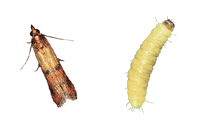
Mediterranean Flour Moth
The Mediterranean flour moth got its name from the location believed to be its origin. It is fairly large for a pantry pest moth, up to ¾" long with a wingspan up to 1" wide. Adult flour moths are gray colored with black specks and wavy black lines on their back. When they are at rest they push up with their front legs, making their backs slope as in the picture - a unique pose that can be used to identify them. Flying adults will be attracted to lights. Mediterranean flour moth larvae are under ¾" long, and white colored with very small black dots. They prefer processed grains and flours, but will feed on other things like cereals, nuts, dog food, and dried fruit. When the larvae hatch they will spin a silken tube, which they live in - unlike the larvae of the Indianmeal moth. These silken tubes are a nuisance in grain mills because they can clog the machinery. When the larvae mature they leave the silk tube in search of a location to pupate. This can lead them far away from the initial food source in some cases. If the larva can find a protected location, a cocoon is not always formed for the pupa stage.
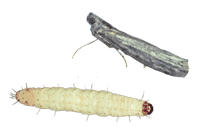
Granary and Rice Weevel
The rice weevil and granary weevil are similar in both looks and behavior. Both weevils are around 1/8" long, although the granary weevil can grow to be a little larger. They are also both colored reddish brown. However, the rice weevil isn't shiny in appearance and has 4 light red marks on its back. The granary weevil is shiny, and solid colored. The rice weevil can fly and is attracted to light, whereas the granary weevil isn't. These weevils infest mainly whole grains like corn, rice, rye, seeds, or beans - but occasionally get into other things. The female weevil bores a hole into a single grain, and lays an egg inside. The egg develops inside the grain, feeding on the insides, until eventually an adult emerges. Before they emerge, it is difficult to tell which grains they are in. But after they hatch out, they leave behind the telltale shell remains. Granary and rice weevils can sometimes be seen wandering around away from the infested material. If they are disturbed, they will hold still and play dead for several minutes.
